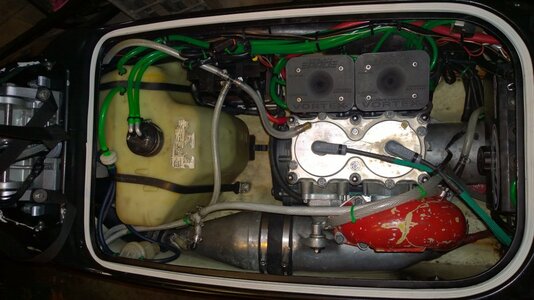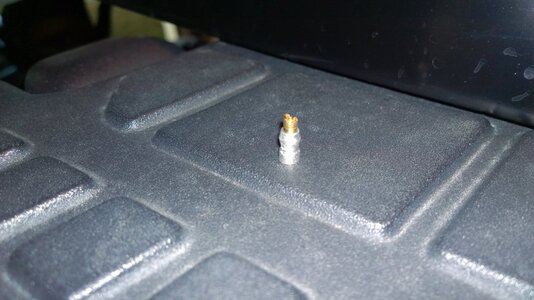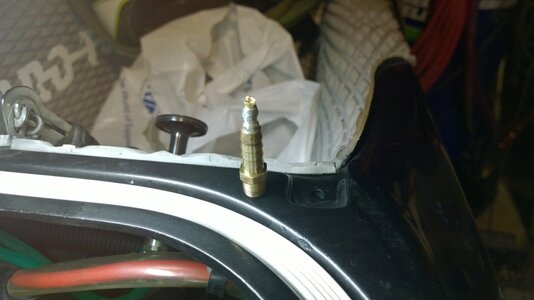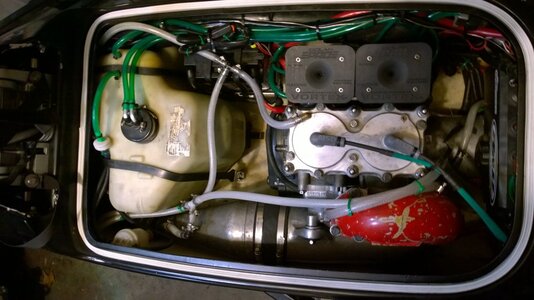Oh, on a side note regarding the Sizzler...if anyone that has one and is interested to know how I have mine set up it is very straight forward other than two mods that should be done by a machine shop. When I bought my manifold two years ago or so, it was bored out to 47mm...sort of. It was Dremel bored and that means it was not consistent. Some areas were just a shade over 49mm so I took it to work and did the best I could to bore it to a clean and true 49mm bore. The head pipe on these are somewhere around 45-46mm stock...I had to bore out the head pipe to match as one would expect, also the gasket was milled to match too, but you can not bore the head pipe down too deeply at 49mm. In fact I would be hesitant to go beyond 1/4" deep at 47mm. For my setup, I set my endmill to only go down 1/4" and Dremeled the new shoulder into a ramp, if you bore the manifold too deeply you will cut into the water jacket. After the boring out work was done, I used JB Weld and filled in about 1/4" of the water jacket at the surface of the bored out side. Once cured, I filed off the most upstanding portions of the JB Weld, and then sanded the rest off using a portion of 220 grit sandpaper wrapped on a flat block of aluminum. Sand slowly. This way the surface stays flat, no bias to one side or the other, or rolled over corners. Once the JB Weld is flat the rest of the surface will quickly shine up. That is the hardest part of the mod work for this pipe. I have read that 47mm is plenty and I probably would have only gone that far with it but it was only due to the Dremel job of somebody else that forced me to go with 49mm. I have no idea how this diameter would compare to a 47mm diameter since I am the only one in my area with a Sizzler. It is possible that my diameter is too large and I am losing power since I have no basis for comparison. I just wanted to make that known if anyone decides to try this same type of mod work. If you are running a stock bore manifold and head pipe from Coffman's, don't be afraid to ask the guys around here with knowledge of these pipes, they are all good guys and genuinely want to help steer you in the right direction.
For water flow control, I used a 120 pilot jet and made my own restricted injector fitting for the stinger... very easy to do. The first thing you would do is take one of those little aluminum screw on caps for the NGK BR8ES spark plugs, a 3/8" brass 1/8NPT plumbing barb, and try to file off just enough of the plug cap diameter that you can make it into a minimal effort press-fit into the brass 3/8" barb. Now the pilot jets for Mikuni carbs have the same thread pitch as those little screw on caps for the spark plugs. So as long as you have not crushed the cap from pressing it into the barb fitting, you now have a water injector that you can calibrate to your liking by simply changing out the jet. Sure you could just shove a jet inline but I tried that once and the jet popped out and flipped sideways...it didn't work out so well...this will not back out. On the head pipe, for mine anyway as I have read there are a few different types of them out there...mine has only two ports. One for water in, one for water out. The water in is the one pointing up in the air closer to the front of the engine. I have noticed there are two different types of 3/8" water barbs. One has a thin wall and one is quite a bit thicker. This was where I made my very small change for today. I changed out the thin wall for the thick to reduce the volume of water coming in by that little bit and slow down the flow going into the exhaust stream in the head pipe. Then I ran a line from my pump (as I prefer to have one cooling line for the pipe and a separate one for the engine) to that fitting (the one on the front of the manifold pointing upward) and put a 90 degree elbow fitting in the second port pointing toward the carbs and aimed the 90 degree outlet toward the stinger. Instead of running straight into the stinger, I ran the maximum flow line directly to the overboard bypass with a T about 4" away from the injector fitting on the stinger. So if you are looking at the T, the max flow is the top of it, and the stinger injector is being supplied by the bottom leg of it...get it? This way the water flow is not under nearly as much pressure swamping out the waterbox but rather the bottom leg of the T just gets the minimal pressure as water will take the path of least resistance. I have had zero coupler issues so far running it this way. At the end of a ride my waterbox has almost no water in it when I run the ski on the trailer to clear out the waterbox. Without totally sealing the headpipe from injecting water into the exhaust stream, I think this is about as close as one can safely come to making these Sizzlers into a dry pipe and not scorch a head pipe coupler. As for temps, my exhaust runs very comfortably cool. I can put my hand on the head pipe after a run and it is just warm, you could probably hold your hand on it all day at that temp.




